Approximate Solution for Electroosmotic Flow of Power-Law Fluids in a Planar Microchannel with Asymmetric Electrochemical Boundary Conditions
Abstract
:1. Introduction
2. Mathematical Formulation
3. Discussions
4. Conclusions
Supplementary Materials
Author Contributions
Acknowledgments
Conflicts of Interest
Appendix A
Appendix B
- (i)
- ,
- (ii)
- ,
- (iii)
- ,
- (iv)
- ,
References
- Lyklema, J. Fundamentals of Interface and Colloid Science: Solid-Liquid Interfaces, 1st ed.; Academic Press: London, UK, 1995; ISBN 978-0-12-460524-4. [Google Scholar]
- Hunter, R.J. Introduction to Modern Colloid Science, 1st ed.; Oxford University Press: Oxford, UK; New York, NY, USA, 1994; ISBN 978-0-19-855386-1. [Google Scholar]
- Li, D. Electrokinetics in Microfluidics; Academic Press: Cambridge, MA, USA, 2004; ISBN 978-0-08-053074-1. [Google Scholar]
- Masliyah, J.H.; Bhattacharjee, S. Electrokinetic and Colloid Transport Phenomena, 1st ed.; Wiley-Interscience: Hoboken, NJ, USA, 2006; ISBN 978-0-471-78882-9. [Google Scholar]
- Chakraborty, S. Electroosmotically driven capillary transport of typical non-Newtonian biofluids in rectangular microchannels. Anal. Chim. Acta 2007, 605, 175–184. [Google Scholar] [CrossRef] [PubMed]
- Das, S.; Chakraborty, S. Analytical solutions for velocity, temperature and concentration distribution in electroosmotic microchannel flows of a non-Newtonian bio-fluid. Anal. Chim. Acta 2006, 559, 15–24. [Google Scholar] [CrossRef]
- Devarakonda, S.B.; Han, J.; Ahn, C.H.; Banerjee, R.K. Bioparticle separation in non-Newtonian fluid using pulsed flow in micro-channels. Microfluid. Nanofluid. 2007, 3, 391–401. [Google Scholar] [CrossRef]
- Kolodner, P. Oscillatory convection in viscoelastic DNA suspensions. J. Non-Newton. Fluid Mech. 1998, 75, 167–192. [Google Scholar] [CrossRef]
- Owens, R.G. A new microstructure-based constitutive model for human blood. J. Non-Newton. Fluid Mech. 2006, 140, 57–70. [Google Scholar] [CrossRef]
- Yilmaz, F.; Gundogdu, M.Y. A critical review on blood flow in large arteries: Relevance to blood rheology, viscosity models, and physiologic conditions. Korea-Aust. Rheol. J. 2008, 20, 197–211. [Google Scholar]
- Park, H.M.; Lee, W.M. Helmholtz–Smoluchowski velocity for viscoelastic electroosmotic flows. J. Colloid Int. Sci. 2008, 317, 631–636. [Google Scholar] [CrossRef] [PubMed]
- Zhao, C.; Zholkovskij, E.; Masliyah, J.H.; Yang, C. Analysis of electroosmotic flow of power-law fluids in a slit microchannel. J. Colloid Interface Sci. 2008, 326, 503–510. [Google Scholar] [CrossRef] [PubMed]
- Tang, G.H.; Li, X.F.; He, Y.L.; Tao, W.Q. Electroosmotic flow of non-Newtonian fluid in microchannels. J. Non-Newton. Fluid Mech. 2009, 157, 133–137. [Google Scholar] [CrossRef]
- Zhao, C.; Yang, C. Nonlinear Smoluchowski velocity for electroosmosis of Power-law fluids over a surface with arbitrary zeta potentials. Electrophoresis 2010, 31, 973–979. [Google Scholar] [CrossRef] [PubMed]
- Vasu, N.; De, S. Electroosmotic flow of power-law fluids at high zeta potentials. Colloids Surf. A Physicochem. Eng. Asp. 2010, 368, 44–52. [Google Scholar] [CrossRef]
- Zhao, C.; Yang, C. An exact solution for electroosmosis of non-Newtonian fluids in microchannels. J. Non-Newton. Fluid Mech. 2011, 166, 1076–1079. [Google Scholar] [CrossRef]
- Babaie, A.; Sadeghi, A.; Saidi, M.H. Combined electroosmotically and pressure driven flow of power-law fluids in a slit microchannel. J. Non-Newton. Fluid Mech. 2011, 166, 792–798. [Google Scholar] [CrossRef]
- Hadigol, M.; Nosrati, R.; Raisee, M. Numerical analysis of mixed electroosmotic/pressure driven flow of power-law fluids in microchannels and micropumps. Colloids Surf. A Physicochem. Eng. Asp. 2011, 374, 142–153. [Google Scholar] [CrossRef]
- Zhao, C.; Yang, C. Electroosmotic flows of non-Newtonian power-law fluids in a cylindrical microchannel. Electrophoresis 2013, 34, 662–667. [Google Scholar] [CrossRef] [PubMed]
- Zhao, C.; Zhang, W.; Yang, C. Dynamic electroosmotic flows of power-law fluids in rectangular microchannels. Micromachines 2017, 8, 34. [Google Scholar] [CrossRef]
- Afonso, A.M.; Alves, M.A.; Pinho, F.T. Electro-osmotic flow of viscoelastic fluids in microchannels under asymmetric zeta potentials. J. Eng. Math. 2011, 71, 15–30. [Google Scholar] [CrossRef]
- Choi, W.; Joo, S.W.; Lim, G. Electroosmotic flows of viscoelastic fluids with asymmetric electrochemical boundary conditions. J. Non-Newton. Fluid Mech. 2012, 187–188, 1–7. [Google Scholar] [CrossRef]
- Qi, C.; Ng, C.-O. Electroosmotic flow of a power-law fluid through an asymmetrical slit microchannel with gradually varying wall shape and wall potential. Colloids Surf. A Physicochem. Eng. Asp. 2015, 472, 26–37. [Google Scholar] [CrossRef] [Green Version]
- Hadigol, M.; Nosrati, R.; Nourbakhsh, A.; Raisee, M. Numerical study of electroosmotic micromixing of non-Newtonian fluids. J. Non-Newton. Fluid Mech. 2011, 166, 965–971. [Google Scholar] [CrossRef]
- Choi, W.; Yun, S.; Choi, D.-S. Electroosmotic flows of power-law fluids with asymmetric electrochemical boundary conditions in a rectangular microchannel. Micromachines 2017, 8, 165. [Google Scholar] [CrossRef]
- Deen, W.M. Analysis of Transport Phenomena; Oxford University Press: New York, NY, USA, 1998; ISBN 978-0-19-508494-8. [Google Scholar]

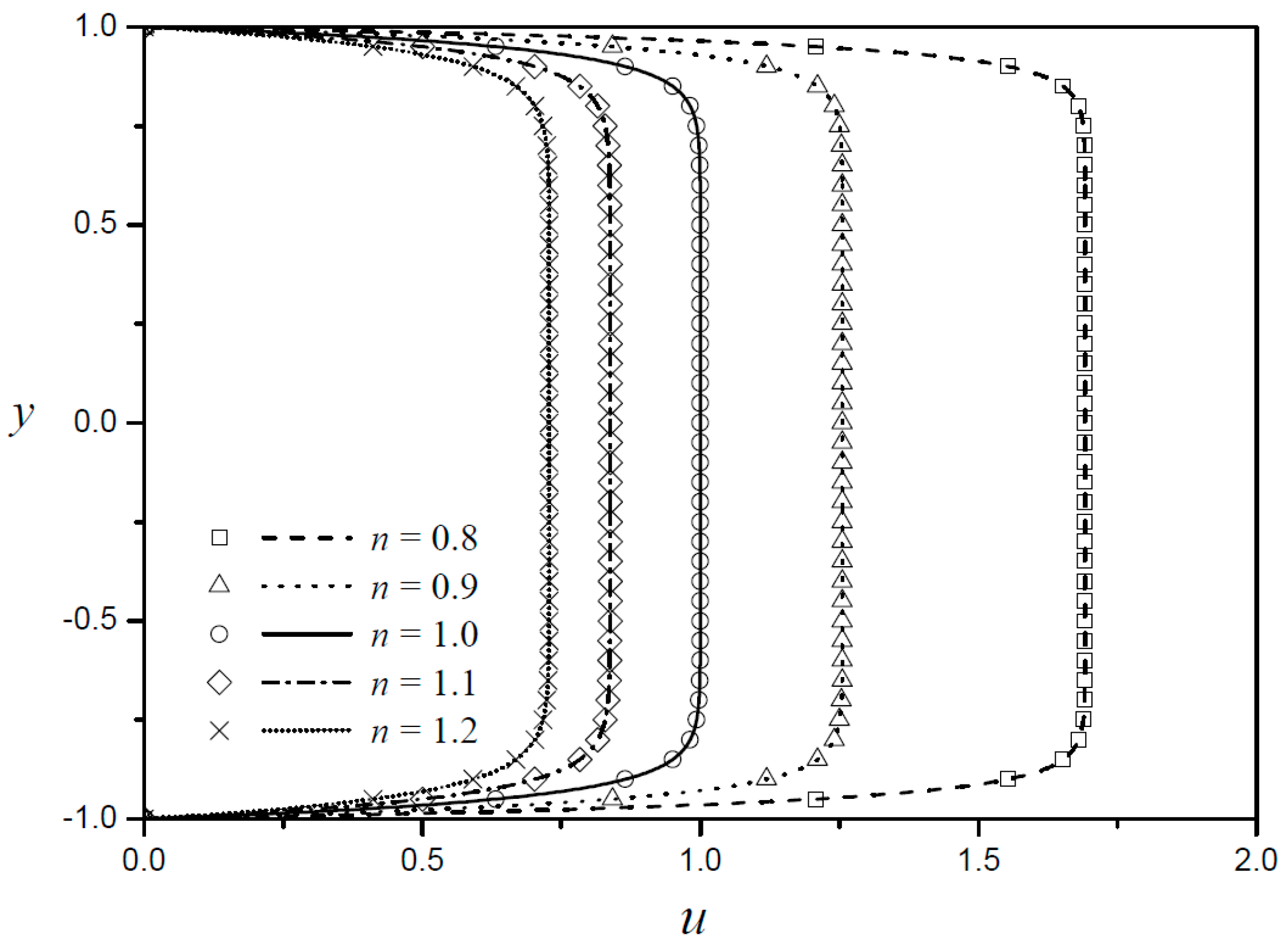
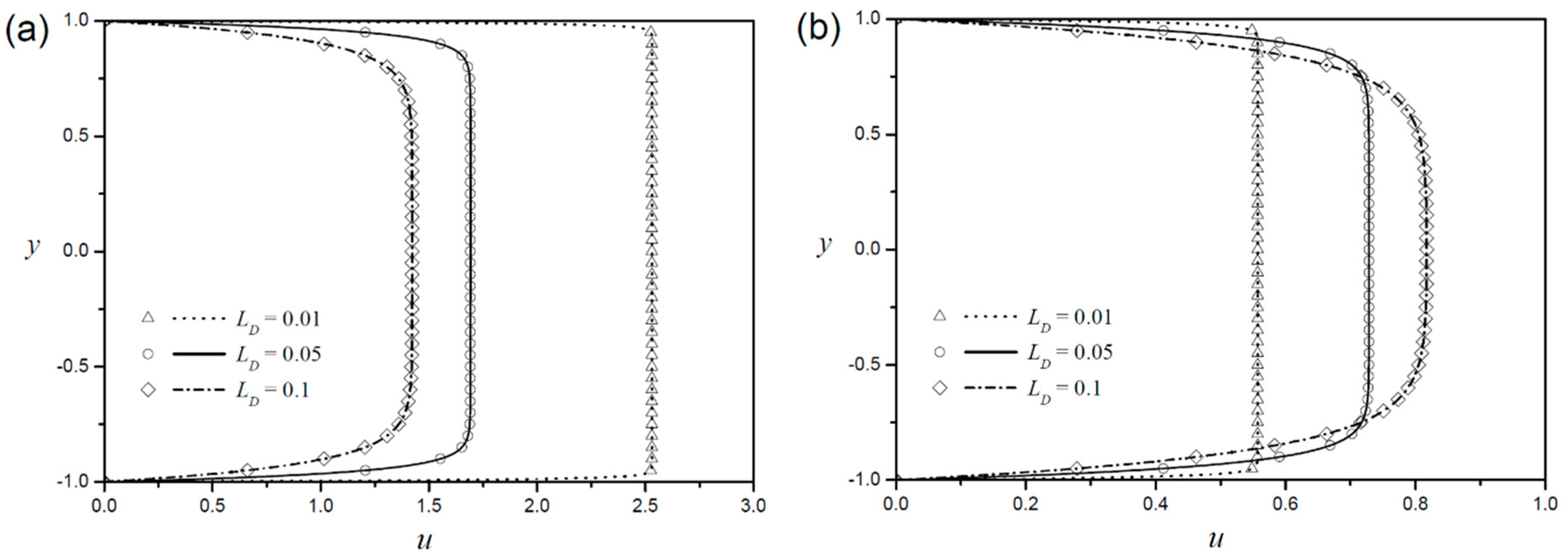
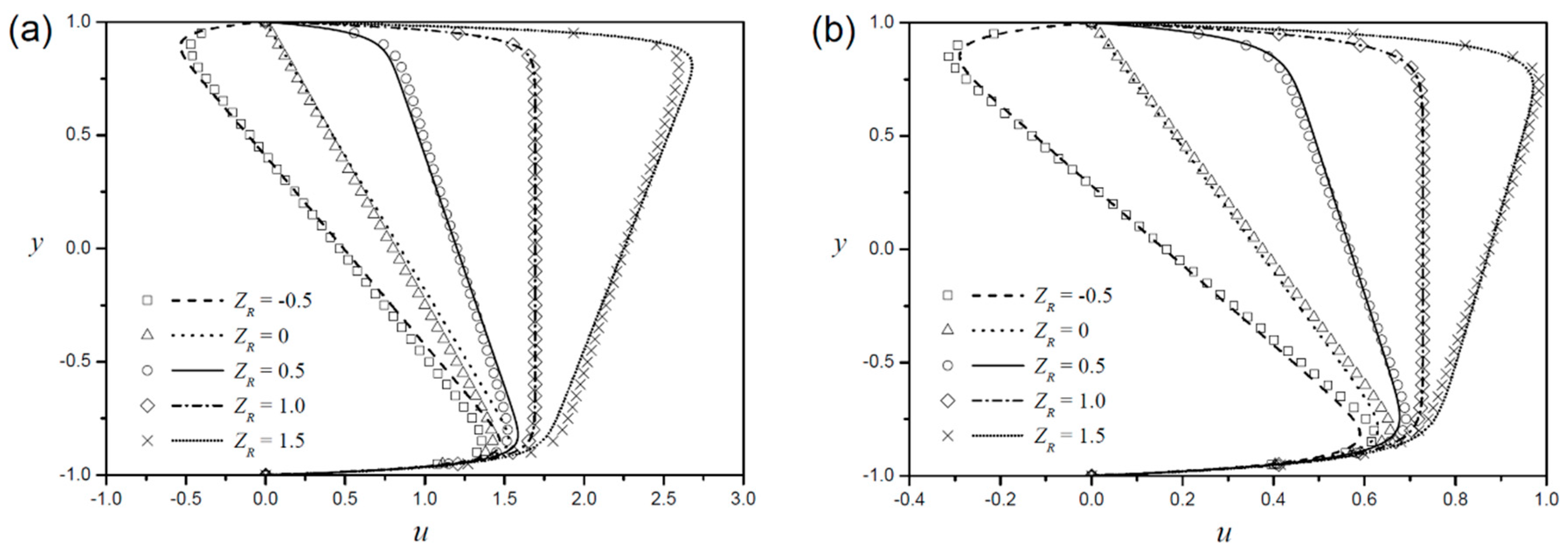
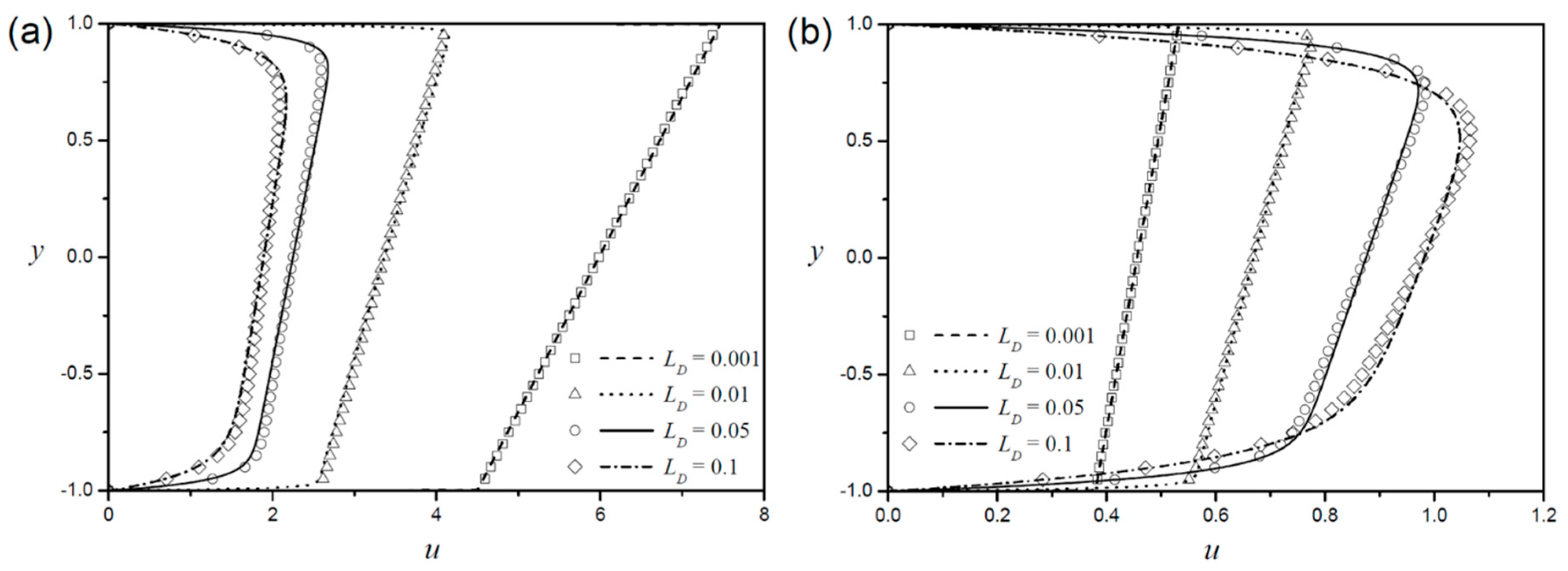
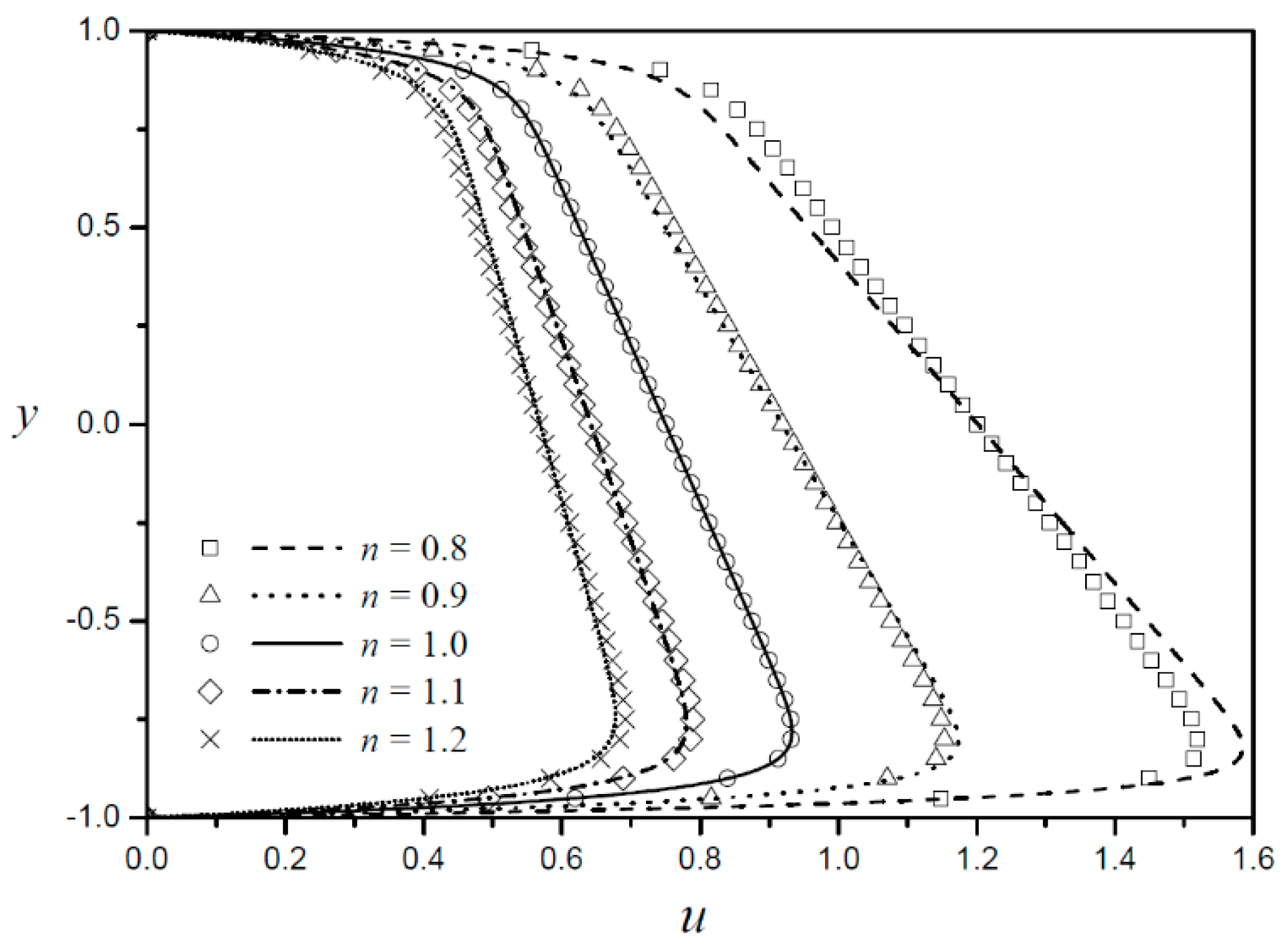
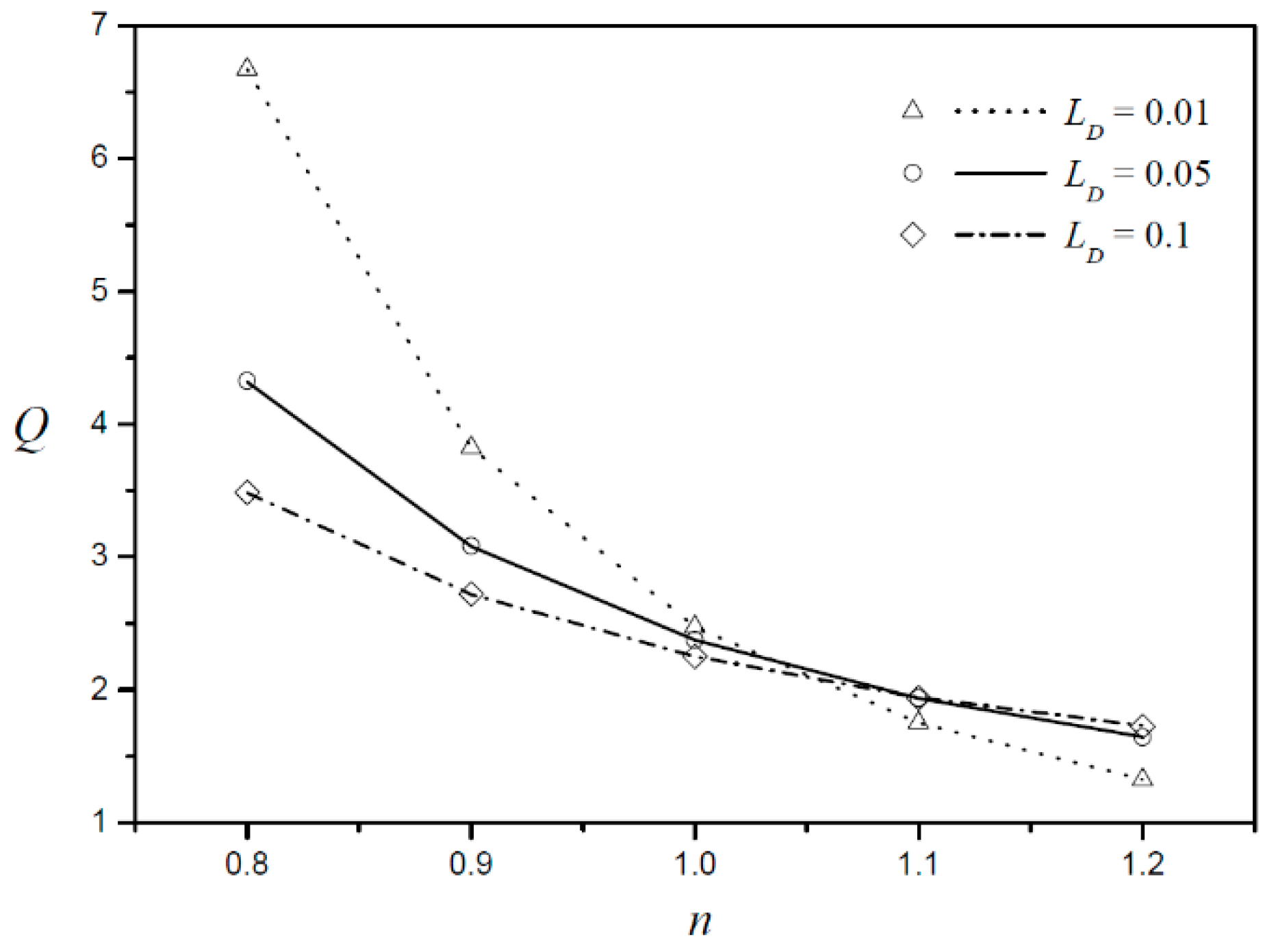
| 0.8 | 0.012 | 0.090 | 0.135 |
| 0.9 | 0.013 | 0.071 | 0.096 |
| 1.0 | 0 | 0 | 0 |
| 1.1 | 0.023 | 0.088 | 0.108 |
| 1.2 | 0.038 | 0.171 | 0.220 |
© 2018 by the authors. Licensee MDPI, Basel, Switzerland. This article is an open access article distributed under the terms and conditions of the Creative Commons Attribution (CC BY) license (http://creativecommons.org/licenses/by/4.0/).
Share and Cite
Choi, W.; Yun, S.; Choi, D.-S. Approximate Solution for Electroosmotic Flow of Power-Law Fluids in a Planar Microchannel with Asymmetric Electrochemical Boundary Conditions. Micromachines 2018, 9, 265. https://doi.org/10.3390/mi9060265
Choi W, Yun S, Choi D-S. Approximate Solution for Electroosmotic Flow of Power-Law Fluids in a Planar Microchannel with Asymmetric Electrochemical Boundary Conditions. Micromachines. 2018; 9(6):265. https://doi.org/10.3390/mi9060265
Chicago/Turabian StyleChoi, WooSeok, Sungchan Yun, and Du-Soon Choi. 2018. "Approximate Solution for Electroosmotic Flow of Power-Law Fluids in a Planar Microchannel with Asymmetric Electrochemical Boundary Conditions" Micromachines 9, no. 6: 265. https://doi.org/10.3390/mi9060265





